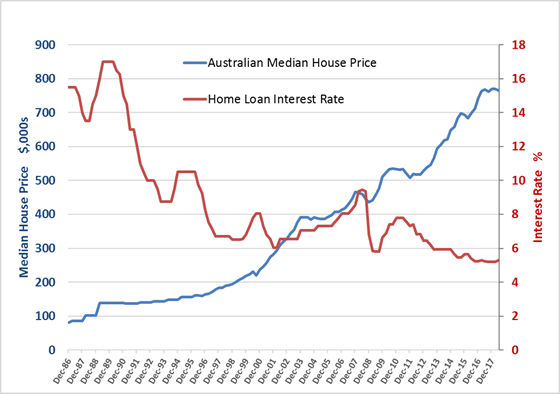Expert Advice with Simon Buckingham 17/08/2018
With several lenders recently increasing their interest rates on home loans, some people are worried that rising interest rates will cause property values to plummet.
The concern with rising interest rates is that if it costs more to hold a property with a mortgage, there will be less people who can afford to buy a house, more properties on the market as "stretched" investors and home owners try to sell up, and that higher rates could therefore cause house prices to fall for an extended period.
Interestingly however, history shows a very different picture - and as sophisticated property investors we should always check the facts before jumping to conclusions...
Do Rising Rates Actually Cause House Prices To Fall?
The chart below shows how the median Australian house price has behaved over the past 30 years, and how home loan interest rates have moved over the same period.

Sources: RBA, REIA
We can make several observations based on this data...
One is that interest rates today are historically quite low, and remain so in spite of recent small rises by a number of lenders.
We're a far cry from the dizzying 17 per cent interest rates of the late 1980's, but we're also far below the pre-GFC heights of almost 10 per cent - and still well below the 2010/11 peak of nearly 8 per cent.
(Incidentally, if you're concerned that under today's lending rules your ability to repay a loan is tested at a 'theoretical' interest rate of 7 per cent or higher, keep in mind that not so long ago we were actually paying interest rates above that level! Being tested at a 7 per cent rate isn't really such a big deal by historical standards.)
Look closer though, and what you see is that upwards movements in interest rates over the last 30 years haven't often resulted in a fall in the median house price.
For instance:
• Rates rose from 14 per cent to 17 per cent in 1988/89. At the same time, the median house price rose by more than 35 per cent, and then simply plateaued for a while.
• The dramatic fall in interest rates from 17 per cent to less than 9 percent between 1990 and 1993 saw barely any change to the Australian median house price, and certainly didn't drive prices up.
• Interest rates rose sharply in 1994 - by almost 2 per cent in a year - but the median house price continued to drift upward in spite of this.
• The sharp fall in interest rates of nearly 4 per cent between 1996 and 1997 does appear to coincide with a rise in the median house price (albeit only a $20,000 increase in dollar terms, but this was a decent rise of 10 per cent based on the median price at the time).
• However, another sudden increase in interest rates in 2000 barely registered in the property market, and the median price happily continued its upward march.
• Successive interest rate increases between 2003 and 2008 only saw the median house price trend sideways for a while before resuming its climb and even accelerating ...before the Global Financial Crisis hit.
• Of course, the RBA made rapid cuts to the cash rate throughout 2009 to help insulate the Australian economy from the effects of the global downturn. In response to the GFC, interest rates dropped like a stone - by around 3.5 per cent in 9 months.
• The Australian median house price fell a little at the outset of the GFC - largely reflecting spooked investors and fearful home buyers rather than interest rates at the time (which were over 9 per cent before the RBA intervened). And then the median price rebounded swiftly.
• A succession of interest rate rises brought typical home loan rates back up to nearly 8 percent by 2011. During this time the median Australian house price had risen again, seemingly undeterred by the rise in interest rates - although we should also bear in mind that the Federal Government was pumping huge amounts of money into the economy through stimulus packages over the same period, including boosts to the First Home Owners Grant.
• More recently, variable interest rates fell from around 7.8 per cent to around 5.2 per cent (and cheaper with some lenders) between 2011 and 2018, before creeping up slightly in recent months. Over the same period, the median house price dipped a little before climbing again and stabilising during 2017.
Conclusions
At best what the historical facts suggest is that sometimes when interest rates fall, the median house price may rise - but it doesn't always happen this way.
There's even less historical evidence to suggest that a rise in interest rates will necessitate a fall in house prices.
In fact, the real data shows this to be the exception rather than the rule!
There are plenty of examples over the last 30 years where Australian housing prices have actually risen at the same time that interest rates were rising.
As noted in previous articles, the recent small increase in interest rates by several lenders is nothing to panic about. But even as rates inevitably creep upward (and any increases are likely to be quite gradual with the RBA keeping the cash rate on hold for now), this won't be the key driver of property price behaviour.
Other factors play a stronger role - such as ease of access to finance, wage trends, population movement, available housing supply, economic confidence and general market sentiment.
These other factors influence property price behaviour at a more fundamental level than interest rates.
No Single Property Market
We should also be wary of treating the Australian housing market as if it is just one single market where all areas perform the same. It is not!
Rather, the Australian housing market is a collection of around 15,000 individual suburbs - each representing its own unique market with its own unique set of dynamics.
Whether interest rates go up, down or sideways, there will always be suburbs where prices are going up, down or sideways independent of what's happening with interest rates.
What's important to us as sophisticated property investors is not so much where interest rates are heading, but what's going on in the specific suburbs where we hold real estate or plan to invest - and how we can ensure that those individual suburb trends work in our favour rather than against us.
But that's a big topic for another time!
Meanwhile, for the latest insights on the property market, plus practical strategies for investing effectively in today’s changing market conditions, make sure you get along to one of our upcoming free in-depth property investing workshops.
...........................................................................
 Simon Buckingham is Director of Results Mentoring and a highly experienced investor. Simon has been investing in property for over 15 years using a broad range of strategies including positive cash flow, renovations, property development and commercial properties, both within Australia and overseas.
Simon Buckingham is Director of Results Mentoring and a highly experienced investor. Simon has been investing in property for over 15 years using a broad range of strategies including positive cash flow, renovations, property development and commercial properties, both within Australia and overseas.
Holding university degrees in Commerce and Law, and with over 10 years' experience as a business consultant, Simon turned his back on corporate life forever following the births of his two children and now spends his time investing, developing property, supporting multiple charities, and building businesses - while teaching others how they can do the same. He has personally coached hundreds of investors in techniques that can be used to profit from property in any market conditions, regularly facilitates public workshops and provides other free resources for property investors through ResultsMentoring.com, and has presented to thousands of people at property conferences and seminars around Australia and New Zealand.
Simon writes the highly regarded Sophisticated Property Investor e-newsletter and his opinions on the property market and real-world investing strategies have featured in Your Investment Property magazine, Smart Property Investment, Channel7 News at 6, Kevin Turner's Real Estate Talk, and Property Observer. He is co-author of the critically acclaimed property book The Real Deal: Property Invest Your Way to Financial Freedom, and a founding Mentor in Australia's award-winning personal mentoring service for property investors: the RESULTS Mentoring Program.
Disclaimer: while due care is taken, the viewpoints expressed by contributors do not necessarily reflect the opinions of Your Investment Property.